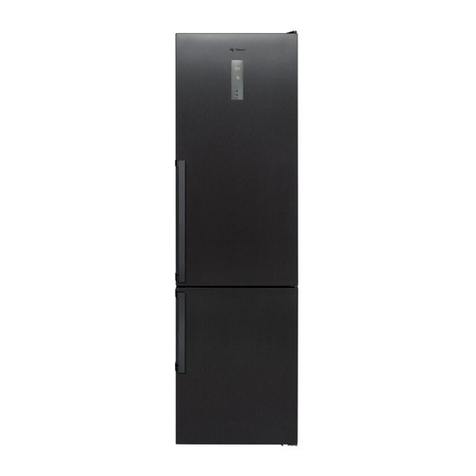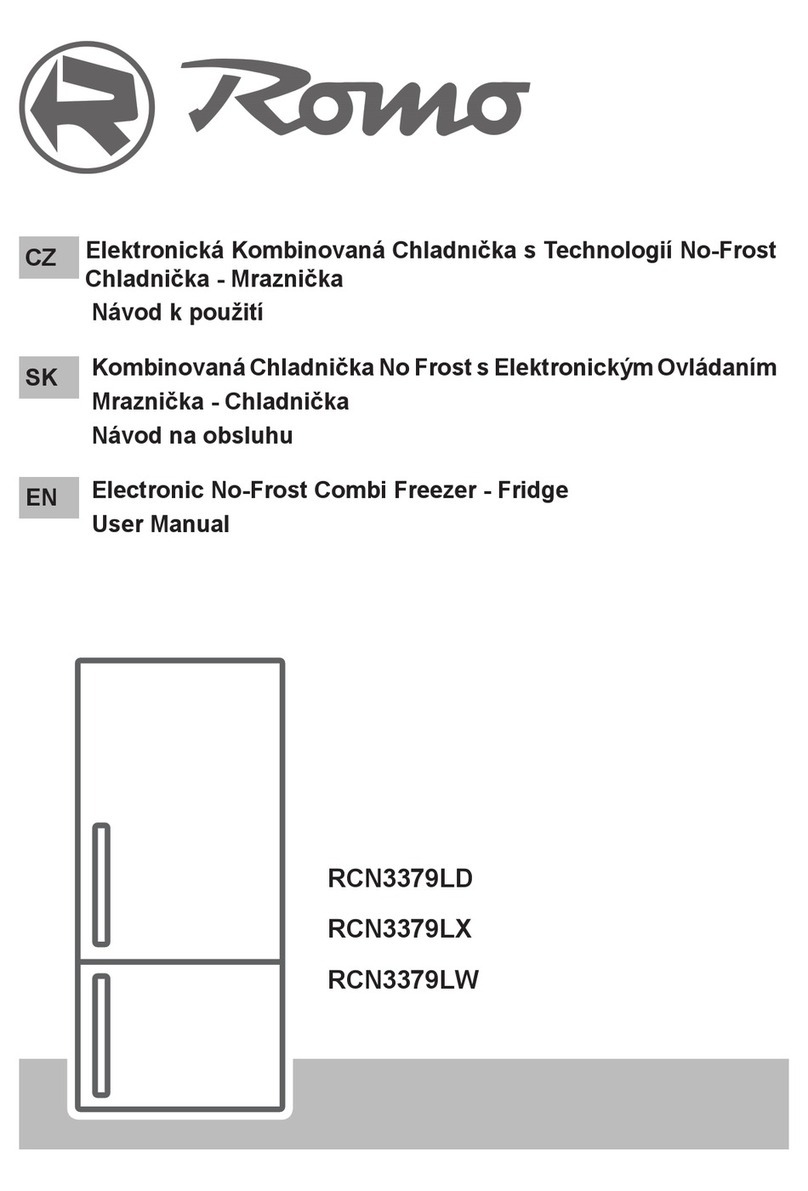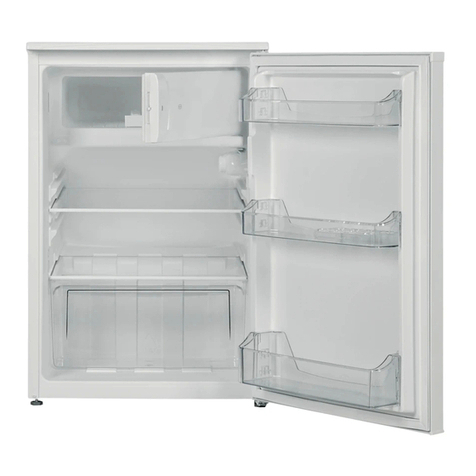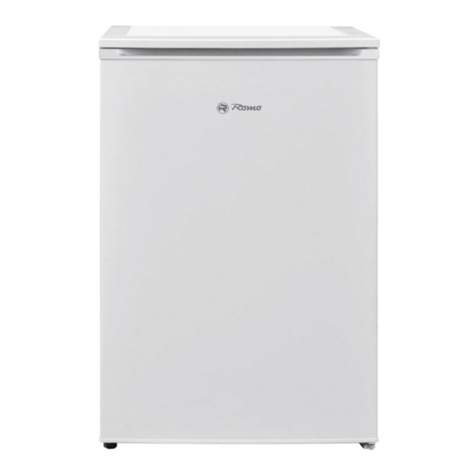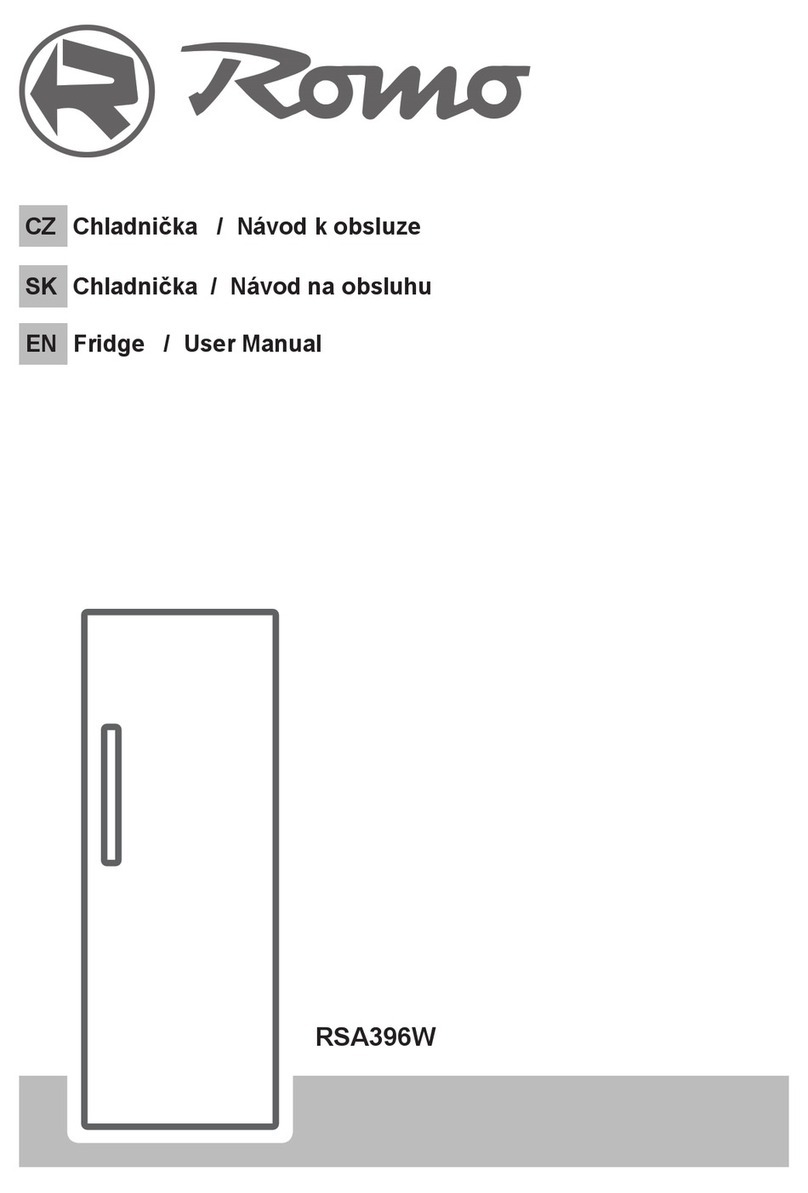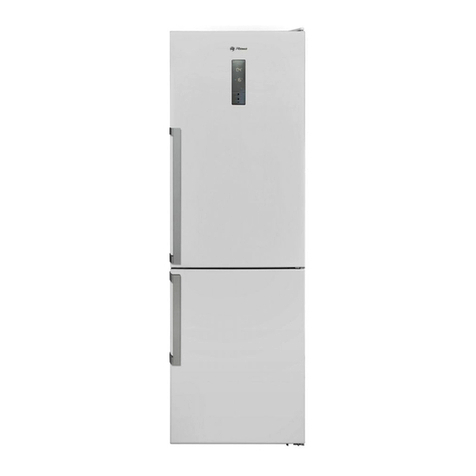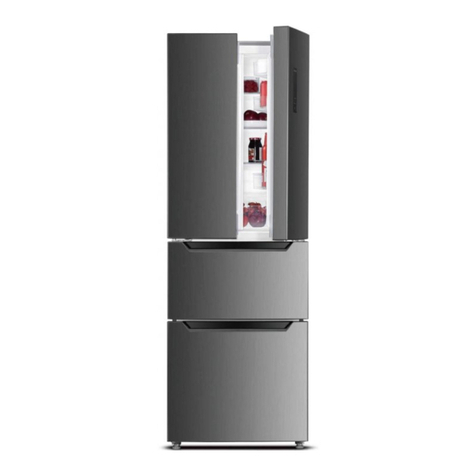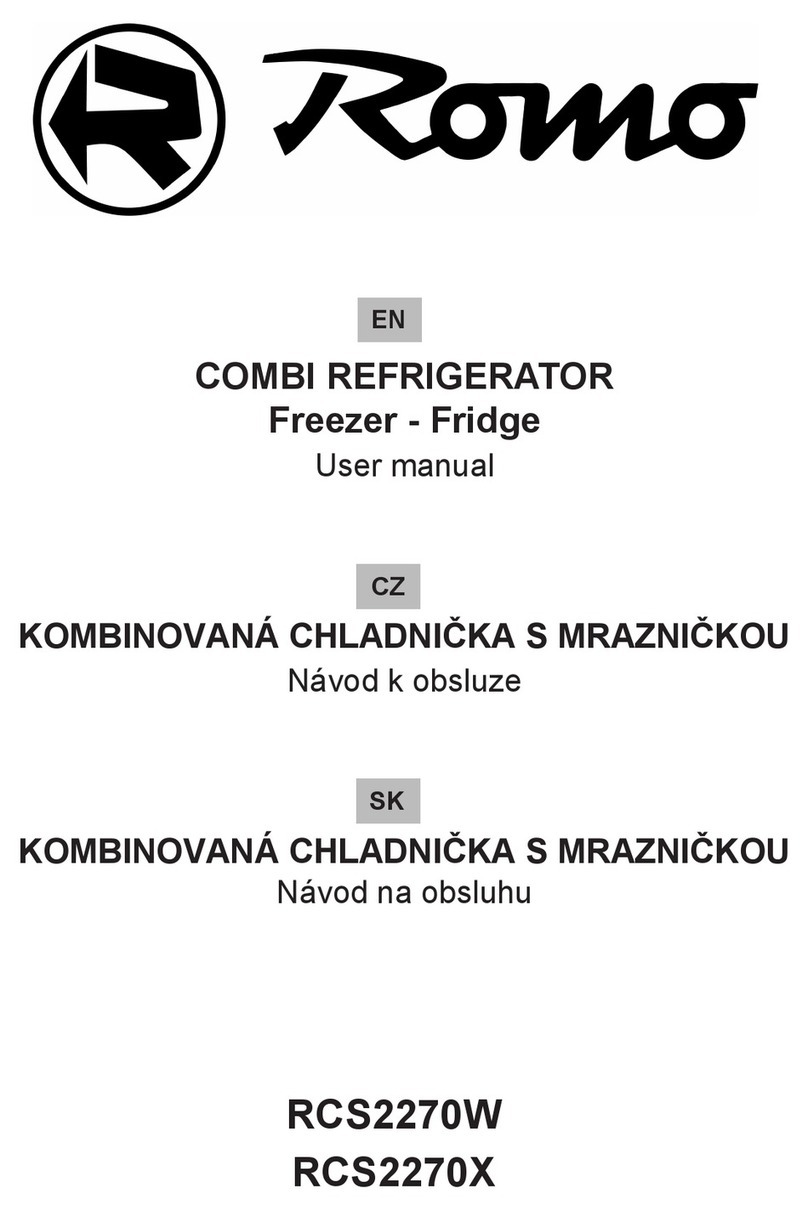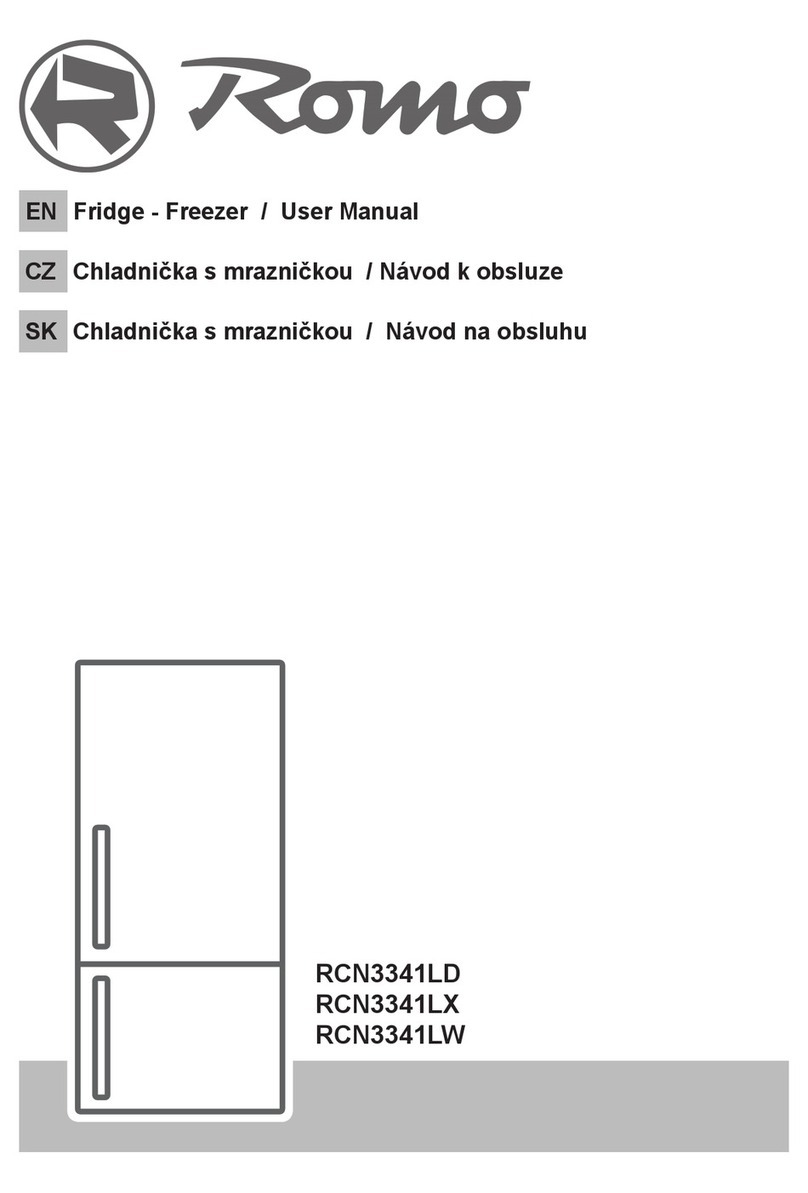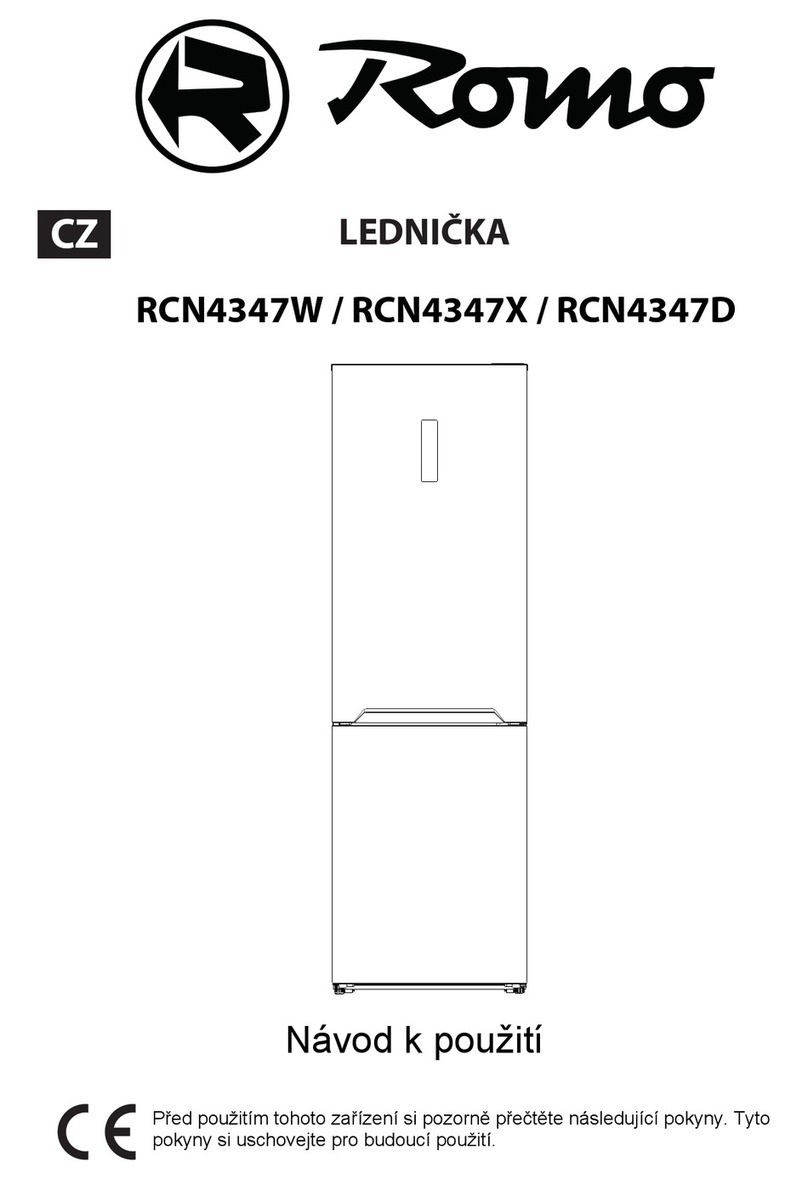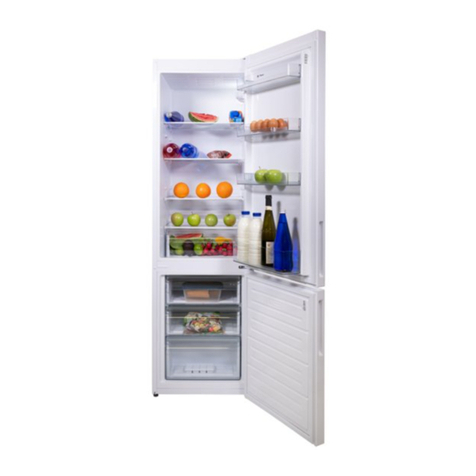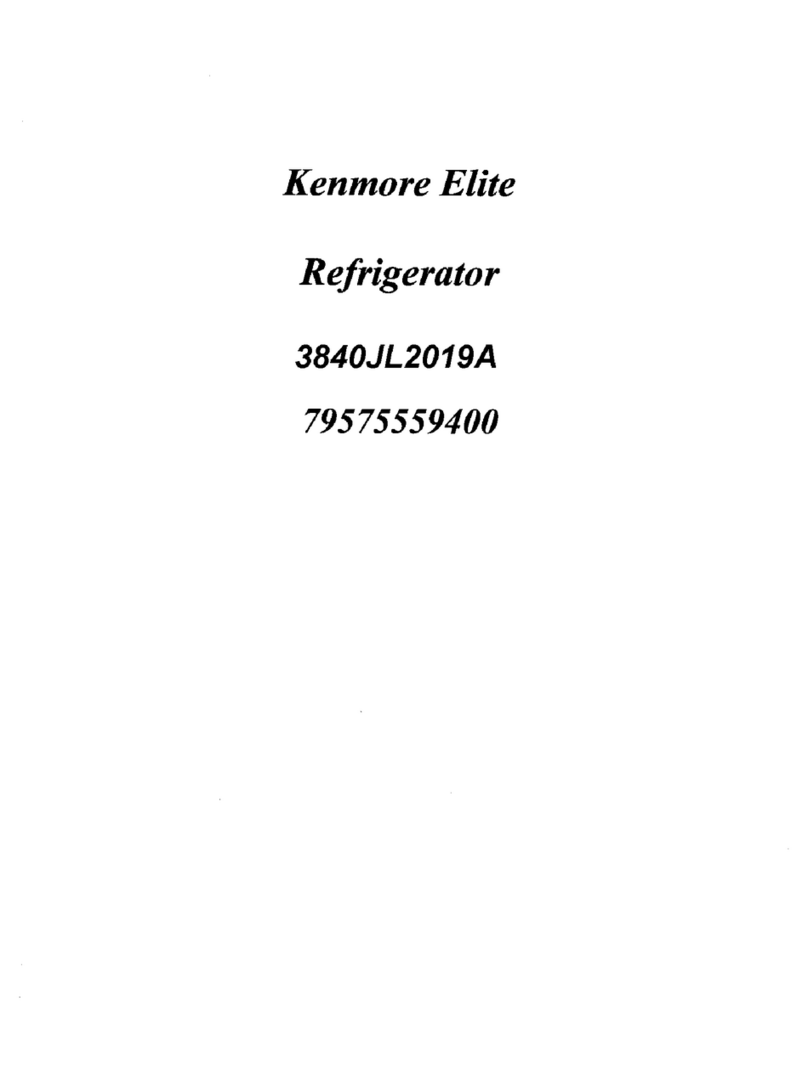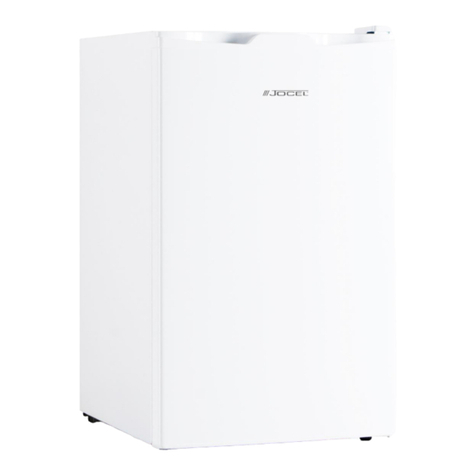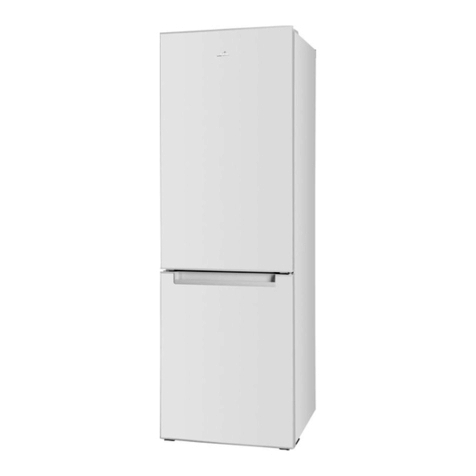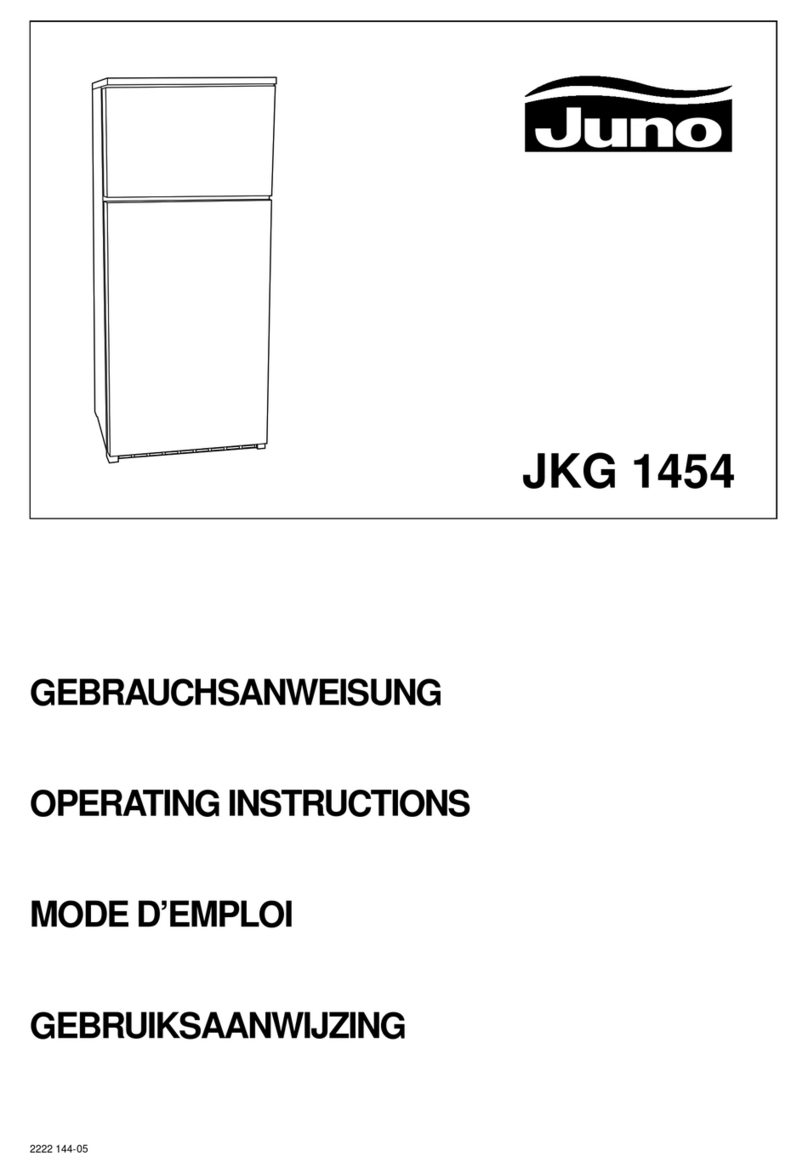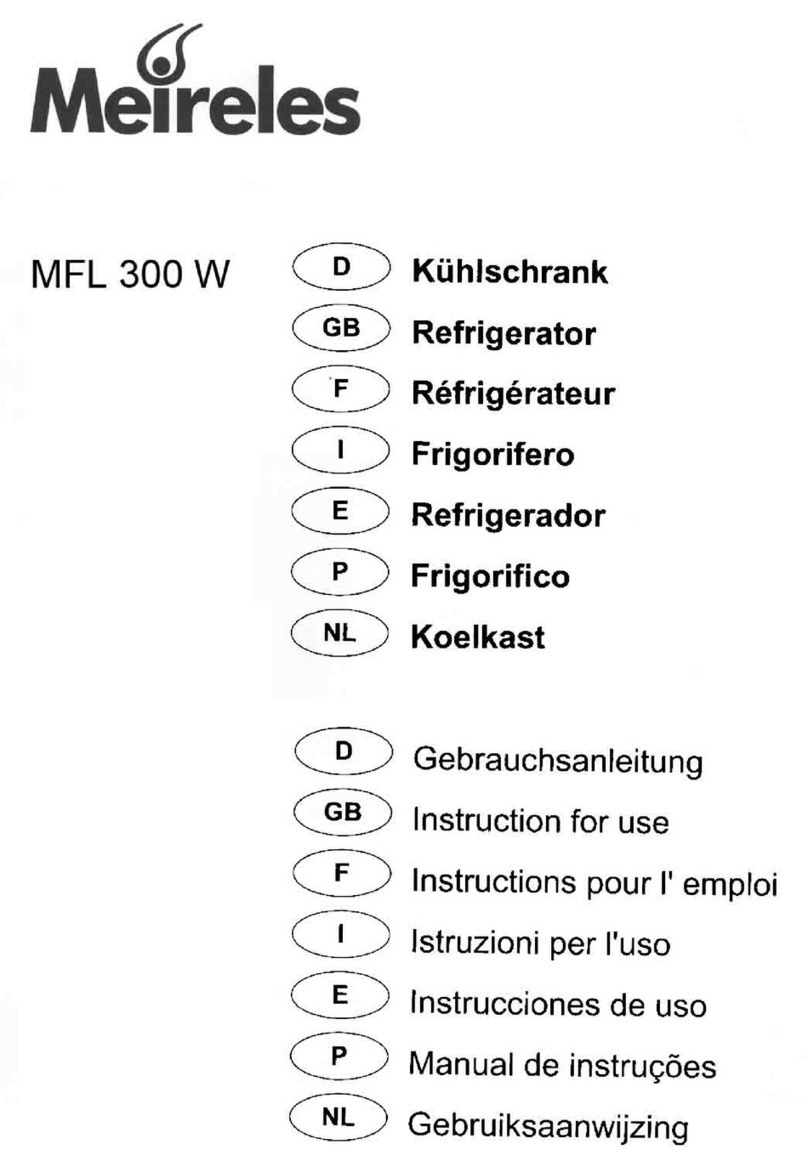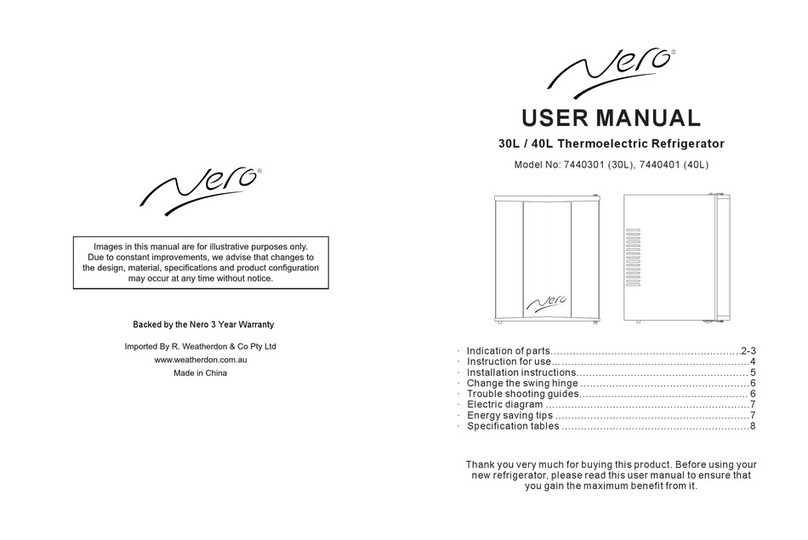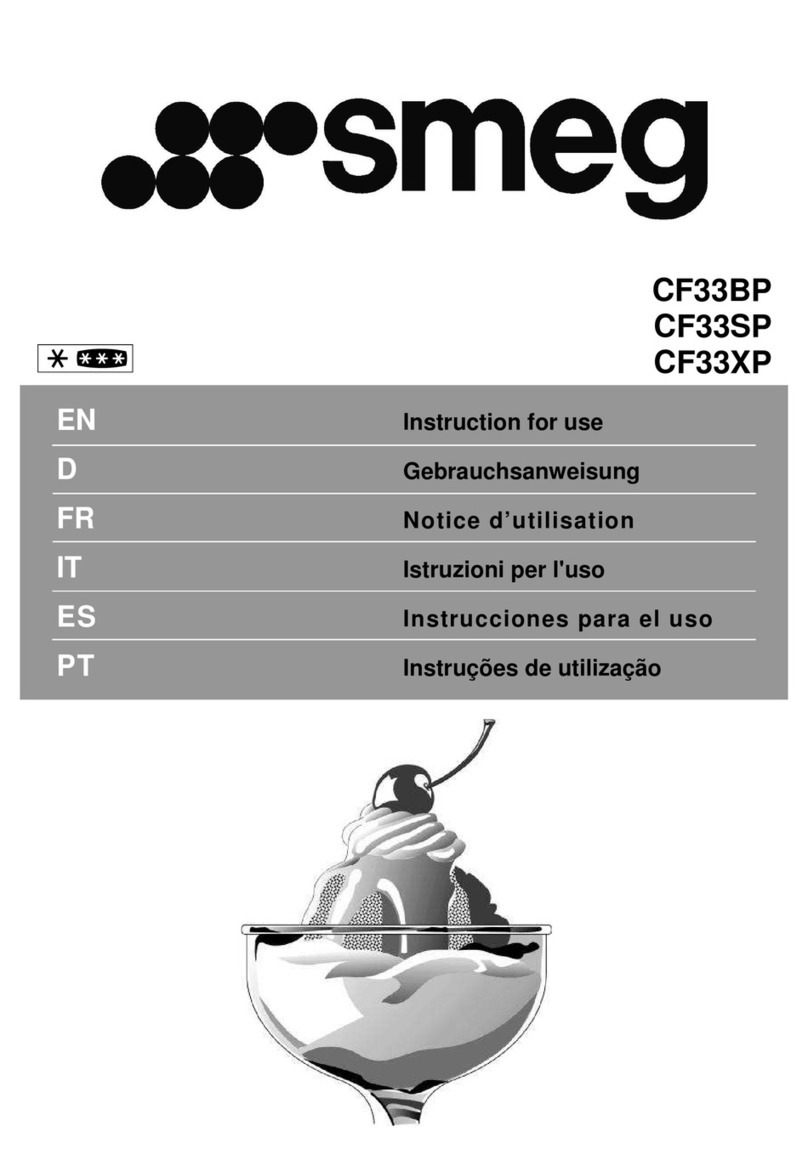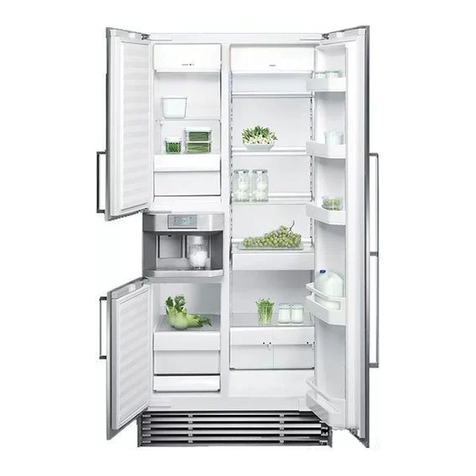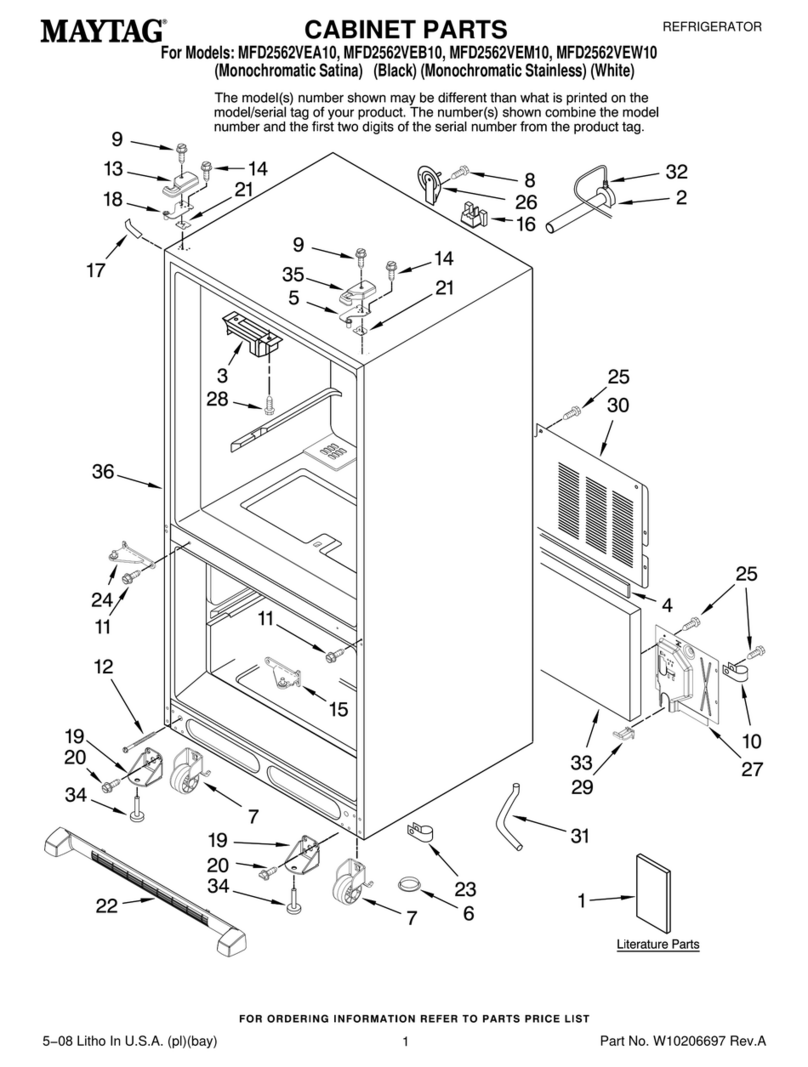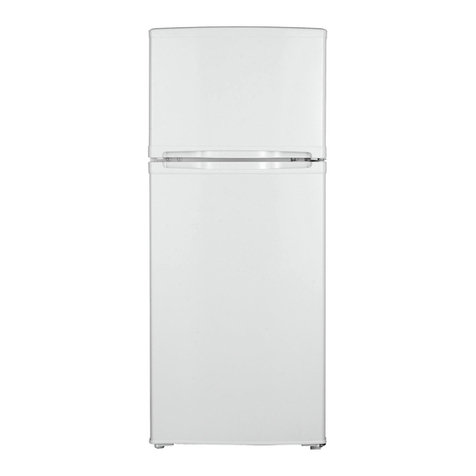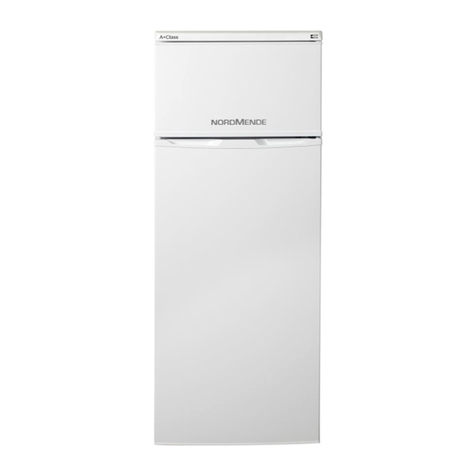Romo RCN295LX User manual

Fridge - Freezer / User ManualEN
RCN295LX
RCN295LD
RCN295LW
Chladnička – mraznička / Návod k použitíCZ
Chladnička – mraznička / Návod na obsluhuSK

EN - 2
Thank you for choosing this product.
This user manual contains important information on safety and instructions intended to
assist you in the operation and maintenance of your appliance.
Please take the time to read this user manual before using your appliance and keep this
book for future reference.
Icon Type Meaning
WARNING Serious injury or death risk
RISK OF ELECTRIC SHOCK Dangerous voltage risk
FIRE Warning; Risk of re / ammable materials
CAUTION Injury or property damage risk
IMPORTANT Operating the system correctly

EN - 3
CONTENTS
1 SAFETY INSTRUCTIONS ............................................................................... 4
1.1 General Safety Warnings ...............................................................................................4
1.2 Inallation warnings .......................................................................................................8
1.3 During Usage..................................................................................................................8
2 DESCRIPTION OF THE APPLIANCE .......................................................... 10
2.1 Dimensions...................................................................................................................11
3 USING THE APPLIANCE .............................................................................. 12
3.1 Information about New Generation Cooling Technology ..............................................12
3.2 Display and Control Panel............................................................................................12
3.2.1 Using the Control Panel.............................................................................................12
3.3 Operating Your Fridge Freezer.....................................................................................13
3.3.1 Super Cool Mode.......................................................................................................13
3.3.2 Super Freeze Mode...................................................................................................13
3.3.3 Activating Economy Mode .........................................................................................13
3.3.4 Screen Saver Mode...................................................................................................13
3.3.5 Cooler Temperature Settings.....................................................................................13
3.3.6 Freezer Temperature Settings...................................................................................13
3.3.7 Door Open Alarm Function........................................................................................14
3.4 Temperature Settings Warnings ...................................................................................14
3.5 Accessories ..................................................................................................................15
3.5.1 Ice Tray (In some models) .......................................................................................15
3.5.2 The Storage Box........................................................................................................15
3.5.3 The Fresh Dial (In some models) ............................................................................15
3.5.4 Adjuable Door Shelf (In some models) .................................................................16
3.5.5 Adjuable Glass Shelf (In some models)................................................................16
3.5.6 Natural Ion Tech (In some models)..........................................................................16
3.5.7 Maxi-fresh preserver (If available).............................................................................16
4 FOOD STORAGE ........................................................................................... 17
4.1 Refrigerator Compartment............................................................................................17
4.2 Freezer Compartment ..................................................................................................18
5 CLEANING AND MAINTENANCE ................................................................ 21
5.1 Defroing .....................................................................................................................21
6 SHIPMENT AND REPOSITIONING .............................................................. 21
6.1 Transportation and Changing Positioning ....................................................................21
6.2 Repositioning the Door.................................................................................................21
7 BEFORE CALLING AFTER-SALES SERVICE ........................................... 22
8 TIPS FOR SAVING ENERGY ........................................................................ 23
9 TECHNICAL DATA ......................................................................................... 24
10 INFORMATION FOR TEST INSTITUTES .................................................. 24
11 CUSTOMER CARE AND SERVICE ............................................................24

EN - 4
1 SAFETY INSTRUCTIONS
1.1 General Safety Warnings
Read this user manual carefully.
WARNING: Keep ventilation openings, in the
appliance enclosure or in the built-in structure, clear of
obstruction.
WARNING: Do not use mechanical devices or
other means to accelerate the defrosting process,
other than those recommended by the manufacturer.
WARNING: Do not use electrical appliances inside
the food storage compartments of the appliance,
unless they are of the type recommended by the
manufacturer.
WARNING: Do not damage the refrigerant circuit.
WARNING: When positioning the appliance,
ensure the supply cord is not trapped or damaged.
WARNING: Do not locate multiple portable socket-
outlets or portable power supplies at the rear of the
appliance.
WARNING: In order to avoid any hazards resulting
from the instability of the appliance, it must be xed in
accordance with the instructions.
If your appliance uses R600a as a refrigerant (this
information will be provided on the label of the cooler)
you should take care during transportation and
installation to prevent the cooler elements from being
damaged. R600a is an environmentally friendly and

EN - 5
natural gas, but it is explosive. In the event of a leak
due to damage of the cooler elements, move your
fridge away from open ames or heat sources and
ventilate the room where the appliance is located for a
few minutes.
• While carrying and positioning the fridge, do not
damage the cooler gas circuit.
• Do not store explosive substances such as aerosol
cans with a ammable propellant in this appliance.
• This appliance is intended to be used in household
and domestic applications such as:
–sta kitchen areas in shops, oces and other
working environments.
–farm houses and by clients in hotels, motels and
other residential type environments.
–bed and breakfast type environments;
–catering and similar non-retail applications.
• If the socket does not match the refrigerator plug,
it must be replaced by the manufacturer, a service
agent or similarly qualied persons in order to avoid
a hazard.
• A specially grounded plug has been connected
to the power cable of your refrigerator. This plug
should be used with a specially grounded socket
of 16 amperes. If there is no such socket in your
house, please have one installed by an authorised
electrician.

EN - 6
• This appliance can be used by children aged from
8 years and above and persons with reduced
physical, sensory or mental capabilities or lack of
experience and knowledge if they have been given
supervision or instruction concerning use of the
appliance in a safe way and understand the hazards
involved. Children shall not play with the appliance.
Cleaning and user maintenance shall not be made
by children without supervision.
• Children aged from 3 to 8 years are allowed to load
and unload refrigerating appliances. Children are not
expected to perform cleaning or user maintenance
of the appliance, very young children (0-3 years old)
are not expected to use appliances, young children
(3-8 years old) are not expected to use appliances
safely unless continuous supervision is given, older
children (8-14 years old) and vulnerable people can
use appliances safely after they have been given
appropriate supervision or instruction concerning
use of the appliance. Very vulnerable people are
not expected to use appliances safely unless
continuous supervision is given.
• If the supply cord is damaged, it must be replaced
by the manufacturer, an authorised service agent or
similar qualied persons, in order to avoid a hazard.
• This appliance is not intended for use at altitudes
exceeding 2000 m.

EN - 7
To avoid contamination of food, please respect the
following instructions:
• Opening the door for long periods can cause
a signicant increase of the temperature in the
compartments of the appliance.
• Clean regularly surfaces that can come in contact
with food and accessible drainage systems
• Store raw meat and sh in suitable containers in the
refrigerator, so that it is not in contact with or drip
onto other food.
• Two-star frozen-food compartments are suitable for
storing pre-frozen food, storing or making ice cream
and making ice cubes.
• One-, two- and three-star compartments are not
suitable for the freezing of fresh food.
• If the refrigerating appliance is left empty for long
periods, switch o, defrost, clean, dry, and leave the
door open to prevent mould developing within the
appliance.

EN - 8
1.2 Installation warnings
Before using your fridge freezer for the rst
time, please pay attention to the following
points:
• The operating voltage for your fridge
freezer is 220-240 V at 50Hz.
• The plug must be accessible after
installation.
• Your fridge freezer may have an odour
when it is operated for the rst time. This
is normal and the odour will fade when
your fridge freezer starts to cool.
• Before connecting your fridge freezer,
ensure that the information on the data
plate (voltage and connected load)
matches that of the mains electricity
supply. If in doubt, consult a qualied
electrician.
• Insert the plug into a socket with an
ecient ground connection. If the socket
has no ground contact or the plug does
not match, we recommend you consult a
qualied electrician for assistance.
• The appliance must be connected
with a properly installed fused socket.
The power supply (AC) and voltage at
the operating point must match with
the details on the name plate of the
appliance (the name plate is located on
the inside left of the appliance).
• We do not accept responsibility for any
damages that occur due to ungrounded
usage.
• Place your fridge freezer where it will not
be exposed to direct sunlight.
• Your fridge freezer must never be used
outdoors or exposed to rain.
• Your appliance must be at least 50 cm
away from stoves, gas ovens and heater
cores, and at least 5 cm away from
electrical ovens.
• If your fridge freezer is placed next to a
deep freezer, there must be at least 2
cm between them to prevent humidity
forming on the outer surface.
• Do not cover the body or top of fridge
freezer with lace. This will aect the
performance of your fridge freezer.
• Clearance of at least 150 mm is required
at the top of your appliance. Do not place
anything on top of your appliance.
• Do not place heavy items on the
appliance.
• Clean the appliance thoroughly before
use (see Cleaning and Maintenance).
• Before using your fridge freezer, wipe all
parts with a solution of warm water and
a teaspoon of sodium bicarbonate. Then,
rinse with clean water and dry. Return all
parts to the fridge freezer after cleaning.
• Use the adjustable front legs to make
sure your appliance is level and stable.
You can adjust the legs by turning them
in either direction. This must be done
before placing food in the appliance.
• Install the two plastic distance guides (the
parts on the black vanes
-condenser- at the rear)
by turning it 90° (as
shown in the gure) to
prevent the condenser
from touching the wall.
• The distance between
the appliance and back wall must be a
maximum of 75 mm.
1.3 During Usage
• Do not connect your fridge freezer to
the mains electricity supply using an
extension lead.
• Do not use damaged, torn or old plugs.
• Do not pull, bend or damage the cord.
• Do not use plug adapter.
• This appliance is designed for use by
adults. Do not allow children to play with
the appliance or hang o the door.
• Never touch the power cord/plug with wet
hands. This may cause a short circuit or
electric shock.
• Do not place glass bottles or cans in the
ice-making compartment as they will
burst when the contents freeze.
• Do not place explosive or ammable
material in your fridge. Place drinks with

EN - 9
high alcohol content vertically in the
fridge compartment and make sure their
tops are tightly closed.
• When removing ice from the ice-making
compartment, do not touch it. Ice may
cause frost burns and/or cuts.
• Do not touch frozen goods with wet
hands. Do not eat ice-cream or ice cubes
immediately after they are removed from
the ice-making compartment.
• Do not re-freeze thawed frozen food. This
may cause health issues such as food
poisoning.
Old and Out-of-order Fridges
• If your old fridge or freezer has a
lock, break or remove the lock before
discarding it, because children may
get trapped inside it and may cause an
accident.
• Old fridges and freezers contain
isolation material and refrigerant with
CFC. Therefore, take care not to harm
environment when you are discarding
your old fridges.
CE Declaration of conformity
We declare that our products meet the
applicable European Directives, Decisions
and Regulations and the requirements
listed in the standards referenced.
Disposal of your old appliance
The symbol on the product or on
its packaging indicates that this
product may not be treated as
household waste. Instead it shall
be handed over to the applicable
collection point for the recycling of electrical
and electronic equipment. By ensuring
this product is disposed of correctly,
you will help prevent potential negative
consequences for the environment and
human health, which could otherwise be
caused by inappropriate waste handling
of this product. For more detailed
information about recycling of this product,
please contact your local city oce, your
household waste disposal service or the
shop where you purchased the product.
Packaging and the Environment
Packaging materials protect
your machine from damage that
may occur during transportation.
The packaging materials are
environmentally friendly as they are
recyclable. The use of recycled material
reduces raw material consumption and
therefore decreases waste production.
Notes:
• Please read the instruction manual
carefully before installing and using your
appliance. We are not responsible for the
damage occurred due to misuse.
• Follow all instructions on your appliance
and instruction manual, and keep this
manual in a safe place to resolve the
problems that may occur in the future.
• This appliance is produced to be used
in homes and it can only be used in
domestic environments and for the
specied purposes. It is not suitable for
commercial or common use. Such use
will cause the guarantee of the appliance
to be cancelled and our company will not
be responsible for any losses incurred.
• This appliance is produced to be used
in houses and it is only suitable for
cooling / storing foods. It is not suitable
for commercial or common use and/or
for storing substances except for food.
Our company is not responsible for any
losses incurred by inappropriate usage of
the appliance.

EN - 10
2 DESCRIPTION OF THE
APPLIANCE
This appliance is not intended to be used
as a built-in appliance.
1
2
5
6
7
8
9
4
B
11
12
A
13 14
310
This presentation is only for
information about the parts of the
appliance. Parts may vary according to the
appliance model.
A) Refrigerator compartment
B) Freezer compartment
1) Wine rack *
2) Refrigerator shelves
3) Storage Box cover
4) Storage Box
5) Freezer upper basket
6) Freezer midle basket
7) Freezer bottom basket
8) Levelling feet
9) Freezer glass shelves *
10) Bottle shelf
11) Adjustable door shelf * / door shelf
12) Door shelf
13) Egg holder
14) Ice box tray
* In some models
General notes:
Fresh Food Compartment (Fridge): Most
ecient use of energy is ensured in the
conguration with the drawers in the bottom
part of the appliance, and shelves evenly
distributed, position of door bins does not
aect energy consumption.
Freezer Compartment (Freezer): Most
Ecient use of energy is ensured in the
conguration with the drawers and bins are
on stock position.

EN - 11
2.1 Dimensions
H1
H2
W2
D2
W1
D1
W3
90o
D3
Space required in use 2
H2 mm 2010
W2 mm 695
D2 mm 694,1
2the height, width and depth of the
appliance including the handle,
plus the space necessary for free
circulation of the cooling air.
Overall space required in use 3
W3 mm 981,6
D3 mm 1168,5
3the height, width and depth of the
appliance including the handle,
plus the space necessary for free
circulation of the cooling air, plus
the space necessary to allow door
opening to the minimum angle
permitting removal of all internal
equipment.
Overall dimensions 1
H1 mm 1860
W1 mm 595
D1 mm 600
1the height, width and depth of the
appliance without the handle.

EN - 12
3 USING THE APPLIANCE
3.1 Information about New Generation
Cooling Technology
Fridges with new-generation cooling
technology have a dierent operating
system to static fridges. Other (static)
fridges may experience a build up of ice
in the freezer compartment due to door
openings and humidity in the food. In such
fridges, regular defrosting is required; the
fridge must be switched o, the frozen
food moved to a suitable container and
the ice which has formed in the freezer
compartment removed.
In fridges with new-generation cooling
technology, a fan blows dry cold air
evenly throughout the fridge and freezer
compartments. The cold air cools your food
evenly and uniformly, preventing humidity
and ice build-up.
In the refrigerator compartment, air
blown by the fan, located at the top of
the refrigerator compartment, is cooled
while passing through the gap behind
the air duct. At the same time, the air is
blown out through the holes in the air duct,
evenly spreading cool air throughout the
refrigerator compartment.
There is no air passage between the
freezer and refrigerator compartments,
therefore preventing the mixing of odours.
As a result, your fridge, with new-
generation cooling technology, provides
you with ease of use as well as a huge
volume and aesthetic appearance.
3.2 Display and Control Panel
1
2
3
4
5
6
7
Using the Control Panel
1. It is super freeze indicator.
2. It is freezer set value screen.
3. It enables the setting value of freezer to
be modied and super freeze mode to be
activated if desired. Freezer may be set
to -16, eco, -20, -22, -24 °C and Super
freeze.
4. It is super cooling indicator.
5. It is cooler set value screen.
6. It enables the setting value of cooler to
be modied and super cool mode to be
activated if desired. Cooler maybe set to
8, 6, eco, 4, 2 °C and super cool.
7. Sr alarm indicator.
3.2.1 Using the Control Panel
Cooler Set Button
The cooler set button allows changes to
be made to the temperature of the cooler

EN - 13
compartment. Super cool and eco mode
can also be activated using this button.
Freezer Set Button
The freezer set button allows changes to
be made to the temperature of the freezer
compartment. Super freezer and eco mode
can also be activated using this button.
Sr Alarm
Sr alarm will change to red if any problems
occur.
3.3 Operating Your Fridge Freezer
3.3.1 Super Cool Mode
When would it be used?
• To cooling huge quantities of food.
• To cooling fast food.
• To cooling food quickly.
• To store seasonal food for a long time.
Activating Super Cool Mode
Push the cooler set button until the super
cool symbol illuminates. The buzzer will
sound twice and the mode will be set.
During Super Cool Mode
Super cool mode can be cancelled in the
same way it is selected.
3.3.2 Super Freeze Mode
When would it be used?
• To freeze a large quantity of food that
cannot t on the fast freeze shelf.
• To freeze prepared foods.
• To freeze fresh food quickly to retain
freshness.
Activating Super Freeze Mode
Push the freezer set button until the super
freez symbol illuminates. The buzzer will
sound twice and the mode will be set.
During Super Freeze Mode
Super freez mode can be cancelled in the
same way it is selected.
3.3.3 Activating Economy Mode
Cooler compartment
• Press the cooler set button until the
economy symbol illumintes.
• If no button is pressed for 1 second the
mode will be set and the buzzer will
sound twice as conrmaiton.
• To cancel, press the cooler set button.
Freezer compartment
• Press the freezer set button until the
economy symbol illumintes.
• If no button is pressed for 1 second the
mode will be set and the buzzer will
sound twice as conrmaiton.
• To cancel, press the freezer set button.
3.3.4 Screen Saver Mode
Purpose
This mode saves energy by switching o all
control panel lighting when the panel is left
inactive.
How to Use
• Screen saver mode will be activated
automatically after 30 seconds.
• If you press any key while the lighting
of the control panel is o, the current
machine settings will reappear on the
display to let you make any change you
wish.
• If you do not cancel the screen saving
mode or press any key for 30 seconds,
control panel will remain o.
To deactivate the screen saving mode,
• To cancel the screen saving mode, rst of
all, you need to press any key to activate
the keys and then press and hold the
freezer set button for 5 seconds.
• To reactivate screen saving mode, press
and hold the freezer set button for 5
seconds.
3.3.5 Cooler Temperature Settings
• Press the cooler set button once.
• When you rst press the button, the
previous value will appear on the setting
indicator of the cooler.
• Whenever you press this button, a lower
temperature will be set (+8 °C, +6 °C,
eco, +4 °C, +2 °C, or super cool).
• If you press the cooler set button until
the super cool symbol appears on the
cooler setting indicator, and do not press
any buttons for 3 second, super cool will
ash.

EN - 14
• If you continue to press the same button,
it will restart from +8 °C.
3.3.6 Freezer Temperature Settings
• Press the freezer set button once.
• When you rst press the button, the
previous value will appear on the setting
indicator of the freezer.
• Whenever you press this button, a lower
temperature will be set (-16 °C, eco,
-20 °C, -22 °C, -24 °C, or super freez).
• If you press the freezer set button until
the super freez symbol appears on the
freezer setting indicator, and do not press
any buttons for 3 second, super freezer
will ash.
• If you continue to press the same button,
it will restart from -16 °C.
Recommended Settings for the Freezer
and Cooler Compartment Temperature
Freezer
Compartment
Cooler
Compartment Remarks
eco 4 oC
For regular
use and best
performance.
-20 oC, -22 oC
or -24 oC4 oC
Recommended
when
environmental
temperature
exceeds 30 °C.
Super
(Super freeze
mode)
4 oC
Must be used
when you wish
to freeze food in
a short period of
time.
eco, -20 oC,
-22 oC or
-24 oC
2 oC
These
temperature
settings must be
used when the
environmental
temperature is
high or if you think
the refrigerator
compartment is
not cool enough
becuse the door
is being opened
frequently.
Freezer
Compartment
Cooler
Compartment Remarks
eco, -20 oC,
-22 oC or
-24 oC
Super
(Super cool
mode)
Must be used
when the
refrigerator
compartment is
overloaded with
food or when
food needs to be
cooled quickly.
3.3.7 Door Open Alarm Function
If fridge door is opened more than 2
minutes, appliance sounds ‘beep beep’.
3.4 Temperature Settings Warnings
• Your appliance is designed to operate in
the ambient temperature ranges stated
in the standards, according to the climate
class stated in the information label. It
is not recommended that your fridge is
operated in the environments which are
outside of the stated temperature ranges.
This will reduce the cooling eciency of
the appliance.
• Temperature adjustments should be
made according to the frequency of
door openings, the quantity of food kept
inside the appliance and the ambient
temperature in the location of your
appliance.
• When the appliance is rst switched on,
allow it to run for 24 hours in order to
reach operating temperature. During this
time, do not open the door and do not
keep a large quantity of food inside.
• A 5 minute delay function is applied
to prevent damage to the compressor
of your appliance when connecting
or disconnecting to mains, or when
an energy breakdown occurs. Your
appliance will begin to operate normally
after 5 minutes.
Climate class and meaning:
T (tropical): This refrigerating appliance
is intended to be used at ambient
temperatures ranging from 16 °C to 43 °C.
ST (subtropical): This refrigerating
appliance is intended to be used at ambient
temperatures ranging from 16 °C to 38 °C.

EN - 15
N (temperate): This refrigerating appliance
is intended to be used at ambient
temperatures ranging from 16 °C to 32 °C.
SN (extended temperate): This
refrigerating appliance is intended to be
used at ambient temperatures ranging from
10 °C to 32 °C.
Important installation instructions
This appliance is designed to work in
dicult climate conditions and is powered
with ‘Freezer Shield’ technology which
ensures that the frozen food in the
freezer will not defrost even if the ambient
temperature falls as low as -15 °C. So
you may then install your appliance in an
unheated room without having to worry
about frozen food in the freezer being
spoilt. When the ambient temperature
returns to normal, you may continue using
the appliance as usual.
3.5 Accessories
Visual and text descriptions in the
accessories section may vary according
to the model of your appliance.
3.5.1 Ice Tray (In some models)
• Fill the ice tray with water and place in
the freezer compartment.
• After the water has completely frozen,
you can twist the tray as shown below to
remove the ice cubes.
3.5.2 The Storage Box
You can adjust and use this department for
2 dierent functions.
Sliding cover
(The images are representative)
Your fridge is delivered to you with the
cover shown in the open position.
Declared energy consumption and volume
are dened according to the Chiller option
of the product.
To use for 0 °C department:
If you want to use this compartment as a
0 °C box, you must take the sliding cover
(indicated in the picture) from the closed
position to the open position.
To use for Crisper department:
If you want to use this compartment as a
Crisper, you must take the sliding cover
(indicated in the picture) from the open
position to the closed position.
While this department is used as a 0
°C department, keeping food in the
Chiller, compartment instead of the freezer
or refrigerator compartments, allows food to
retain freshness and avour for longer,
while preserving its fresh appearance.
When the Chiller tray becomes dirty,
remove it and wash with water. Water
freezes at 0°C, but food containing salt or
sugar freezes at temperatures lower than
this. The Chiller compartment can be used
for storing foods such as raw sh, lightly
pickled food, rice, and so on.
Pull the chiller shelf out towards you.
The cover will open automatically.
Do not put food you want to freeze or ice
trays (to make ice) in this compartment.
3.5.3 The Fresh Dial (In some models)
(The images are representative)
or

EN - 16
(The images are representative)
If the crisper is full, the fresh dial located
in front of the crisper should be opened.
This allows the air in the crisper and the
humidity rate to be controlled, to increase
the life of food within.
The dial, located behind the shelf, must be
opened if any condensation is seen on the
glass shelf.
3.5.4 Adjustable Door Shelf (In some
models)
Six dierent height adjustments can be
made to provide storage areas that you
need by adjustable door shelf.
To change the position of adjustable door
shelf ;
Hold the bottom of the shelf and pull the
buttons on the side of
the door shelf
direction of arrow.
(Fig.1)
Position door shelf
the height you need
by moving up and
down. After you get
the position that you
want the door shelf,
release the buttons on
the side of the door
shelf (Fig.2) Before
releasing the door
shelf, move up down
and make sure the
door shelf is xed.
Note: Before moving door shelf is
loaded, you must hold the shelf by
supporting the bottom. Otherwise, door
Fig. 1
Fig. 2
shelf could fall o the rails due to the
weight. So damage may occur on the door
shelf or rails.
3.5.5 Adjustable Glass Shelf (In some
models)
Adjustable glass shelf mechanism provides
higher storage spaces with a simple
movement. To cover the glass shelf, push
it.
Fig. 1 Fig. 2
You can load your food as you want in the
resulting extra space. To bring the shelf in
its original position, pull it toward you.
3.5.6 Natural Ion Tech (In some models)
Natural Ion Tech spreads negative ions
which neutralize particles of unpleasant
smell and dust in the air.
By removing these particles from the air in
the refrigerator, Natural Ion Tech improves
air quality and eliminates odours.
Ioniser
• This feature is optional. It may not exist
on your product.
• The location of your ioniser device may
vary from product to product.
3.5.7 Maxi-fresh preserver (If available)
Maxi Fresh Preserver technology helps to
remove ethylene gas (a
volatile organic compound
released naturally from fresh
foods) and unpleasant odors
from the crisper.

EN - 17
In this way, food stays fresh for a longer
time.
• Maxi Fresh Preserver must be cleaned
once in a year. The lter should be waited
for 2 hours at 65°C in a oven.
• To clean the lter, please remove the
back cover of the lter box by pulling it in
the direction of the arrow.
• The lter should not be washed with
water or any detergent.
Maxi Fresh Preserver
(In some models)
(The images are representative)
4 FOOD STORAGE
4.1 Refrigerator Compartment
For normal operating conditions, set the
temperature of the cooler compartment to
+4 or +6 oC.
• To reduce humidity and avoid the
consequent formation of frost, always
store liquids in sealed containers in the
refrigerator. Frost tends to concentrate in
the coldest parts of the evaporating liquid
and, in time, your appliance will require
more frequent defrosting.
• Cooked dishes must remain covered
when they are kept in the fridge.Do
not place warm foods in fridge.Place
them when they are cool, otherwise the
temperature/humidity inside the fridge will
increases, reducing the fridge’s eciency.
• Make sure no items are in direct contact
with the rear wall of the appliance as
frost will develop and packaging will stick
to it. Do not open the refrigerator door
frequently.
• We recommend that meat and clean sh
are loosely wrapped and stored on the
glass shelf just above the vegetable bin
where the air is cooler, as this provides
the best storage conditions.
• Store loose fruit and vegetable items in
the crisper containers.
• Storing fruit and vegetables separately
helps prevent ethylene-sensitive
vegetables (green leaves, broccoli,
carrot, etc.) being aected by ethylene-
releaser fruits (banana, peach, apricot,
g etc.).
• Do not put wet vegetables into the
refrigerator.
• Storage time for all food products
depends on the initial quality of the food
and an uninterrupted refrigeration cycle
before refrigerator storage.
• Water leaking from meat may
contaminate other products in the
refrigerator. You should package meat
products and clean any leakages on the
shelves.
• Do not put food in front of the air ow
passage.
• Consume packaged foods before the
recommended expiry date.
Do not allow food to come into contact with
the temperature sensor, which is located
in the refrigerator compartment, in order
to keep the refrigerator compartment at
optimum temperature.
• For normal working conditions, it will
be sucient to adjust the temperature
setting of your refrigerator to +4 °C.
• The temperature of the fridge
compartment should be in the range
of 0-8 °C, fresh foods below 0 °C are
iced and rotted, bacterial load increases
above 8 °C, and spoils.
• Do not put hot food in the refrigerator
immediately, wait for the temperature
to pass outside. Hot foods increase the
degree of your refrigerator and cause
food poisoning and unnecessary spoiling
of the food.

EN - 18
• Meat, sh, etc. should be store in the
chiller compartment of the food, and the
vegetable compartment is preferred for
vegetables. (if available)
• To prevent cross contamination, meat
products and fruit vegetables are not
stored together.
• Foods should be placed in the refrigerator
in closed containers or covered to
prevent moisture and odors.
The table below is a quick guide to show
you the most ecient way to store the
major food groups in your refrigerator
compartment.
Food Maximum
storage time
How and where to
store
Vegetables
and fruits 1 week Vegetable bin
Meat and
sh 2 - 3 days
Wrap in plastic foil,
bags, or in a meat
container and store
on the glass shelf
Fresh
cheese 3 - 4 days On the designated
door shelf
Butter and
margarine 1 week On the designated
door shelf
Bottled
products
e.g. milk
and
yoghurt
Until the
expiry date
recommended
by the
producer
On the designated
door shelf
Eggs 1 month On the designated
egg shelf
Cooked
food 2 days All shelves
NOTE:
Potatoes, onions and garlic should not
be stored in the refrigerator.
4.2 Freezer Compartment
• The freezer is used for storing frozen
food, freezing fresh food, and making ice
cubes.
• Food in liquid form should be frozen
in plastic cups and other food should
be frozen in plastic folios or bags.For
freezing fresh food; wrap and seal fresh
food properly, that is the packaging
should be air tight and shouldn’t leak.
Special freezer bags, aluminum foil
polythene bags and plastic containers
are ideal.
• Do not store fresh food next to frozen
food as it can thaw the frozen food.
• Before freezing fresh food, divide it into
portions that can be consumed in one
sitting.
• Consume thawed frozen food within a
short period of time after defrosting
• Always follow the manufacturer's
instructions on food packaging when
storing frozen food. If no information is
provided food, should not be stored for
more than 3 months from the date of
purchase.
• When purchasing frozen food, make sure
that it has been stored under appropriate
conditions and that the packaging is not
damaged.
• Frozen food should be transported in
appropriate containers and placed in the
freezer as soon as possible.
• Do not purchase frozen food if the
packaging shows signs of humidity
and abnormal swelling. It is probable
that it has been stored at an unsuitable
temperature and that the contents have
deteriorated.
• The storage life of frozen food depends
on the room temperature, the thermostat
setting, how often the door is opened,
the type of food, and the length of time
required to transport the product from
the shop to your home. Always follow the
instructions printed on the packaging and
never exceed the maximum storage life
indicated.
• If the freezer door has been left open for
a long time or not closed properly, frost
will form and can prevent ecient air
circulation. To resolve this, unplug the
freezer and wait for it to defrost. Clean
the freezer once it has fully defrosted.
• The freezer volume stated on the label is
the volume without baskets, covers, and
so on.
• Do not refreeze thawed food. It may pose

EN - 19
a danger to your health and cause problems such as food poisoning.
NOTE: If you attempt to open the freezer door immediately after closing it, you will nd
that it will not open easily. This is normal. Once equilibrium has been reached, the door will
open easily.
• Use the fast freezing shelf to freeze home cooking (and any other food which needs to
be frozen quickly) more quickly because of the freezing shelf’s greater freezing power.
Fast freezing shelf is the bottom drawer of the freezer compartment.
• To use the maximum capacity of the freezer compartment, use the glass shelves for the
upper and middle section, and use the lower basket for the bottom section.
The table below is a quick guide to show you the most ecient way to store the major
food groups in your freezer compartment.
Meat and sh Preparation Maximum storage time
(months)
Steak Wrap in foil 6 - 8
Lamb meat Wrap in foil 6 - 8
Veal roast Wrap in foil 6 - 8
Veal cubes In small pieces 6 - 8
Lamb cubes In pieces 4 - 8
Minced meat In packaging without using spices 1 - 3
Giblets (pieces) In pieces 1 - 3
Bologna sausage/salami Should be kept packaged even if it has a membrane 1 - 3
Chicken and turkey Wrap in foil 4 - 6
Goose and duck Wrap in foil 4 - 6
Deer, rabbit, wild boar In 2.5 kg portions or as llets 6 - 8
Freshwater sh
(Salmon, Carp, Crane,
Catsh)
After cleaning the bowels and scales of the sh,
wash and dry it. If necessary, remove the tail and
head.
2
Lean sh (Bass, Turbot,
Flounder) 4
Fatty shes (Tuna,
Mackerel, Bluesh,
Anchovy)
2 - 4
Shellsh Clean and in a bag 4 - 6
Caviar In its packaging, or in an aluminium or plastic
container 2 - 3
Snails In salty water, or in an aluminium or plastic container 3
NOTE: Thawed frozen meat should be cooked as fresh meat. If the meat is not cooked after defrosting, it
must not be re-frozen.
Vegetables and Fruits Preparation Maximum storage time
(months)
String beans and beans Wash, cut into small pieces and boil in water 10 - 13
Beans Hull, wash and boil in water 12
Cabbage Clean and boil in water 6 - 8
Carrot Clean, cut into slices and boil in water 12

EN - 20
Vegetables and Fruits Preparation Maximum storage time
(months)
Pepper Cut the stem, cut into two pieces, remove the core
and boil in water 8 - 10
Spinach Wash and boil in water 6 - 9
Cauliower Remove the leaves, cut the heart into pieces and
leave it in water with a little lemon juice for a while 10 - 12
Eggplant Cut into pieces of 2cm after washing 10 - 12
Corn Clean and pack with its stem or as sweet corn 12
Apple and pear Peel and slice 8 - 10
Apricot and Peach Cut into two pieces and remove the stone 4 - 6
Strawberry and
Blackberry Wash and hull 8 - 12
Cooked fruits Add 10 % of sugar to the container 12
Plum, cherry, sourberry Wash and hull the stems 8 - 12
Maximum storage time
(months)
Thawing time at room
temperature (hours)
Thawing time in oven
(minutes)
Bread 4 - 6 2 - 3 4-5 (220-225 °C)
Biscuits 3 - 6 1 - 1,5 5-8 (190-200 °C)
Pastry 1 - 3 2 - 3 5-10 (200-225 °C)
Pie 1 - 1,5 3 - 4 5-8 (190-200 °C)
Phyllo dough 2 - 3 1 - 1,5 5-8 (190-200 °C)
Pizza 2 - 3 2 - 4 15-20 (200 °C)
Dairy products Preparation Maximum storage time
(months) Storage conditions
Packet (Homogenized)
Milk In its own packet 2 - 3 Pure Milk – in its own packet
This manual suits for next models
2
Table of contents
Languages:
Other Romo Refrigerator manuals
